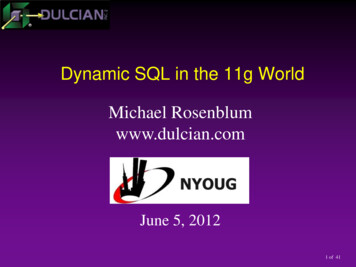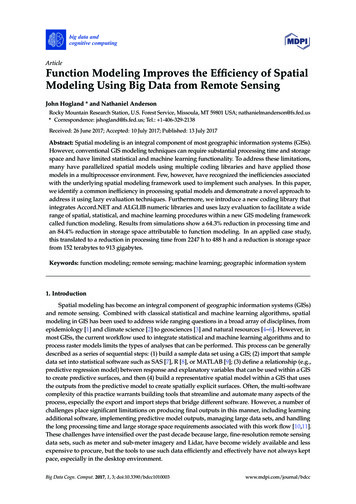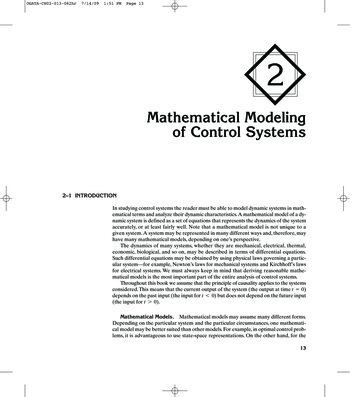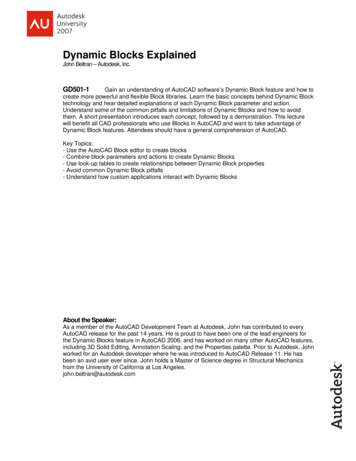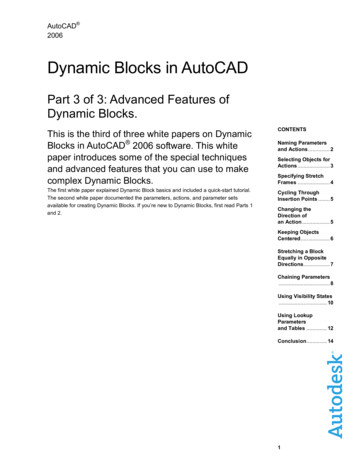
Transcription
Prentice Hall Informationand System Sciences SeriesThomas Kailath, EditorAnderson & MooreAnderson & MooreAstrljm & WittenmarkBasseville & NikiforovBoyd & BarrattDickinsonGardnerGoodwin & SinGray & DavissonGrewal & AndrewsHaykinHaykin, ed.JainJamshidi, Tarokh, & ShafaiJohanssonJohnsonKailathKumar & Varaiy aKungKungKung, Whitehouse, &Kailath, Eds.Kwakemaak & SivanLandauLjungLjung & GladMacovskiMelsa & SageMiddleton & GoodwinNarendra & AnnaswamyPoratRughSastry & BodsonSoliman & SrinathSpilkerWilliamsOptimal Control: Linear Quadratic MethodsOptimal FilteringComputer-Controlled Systems: Theory and Design, second editionDetection of Abrupt Changes: Theory and ApplicationLinear Controller Design: Limits of PegormanceSystems: Analysis, Design & ComputationStatistical Spectral Analysis: A Nonprobabilistic TheoryAdaptive Filtering, Prediction, and ControlRandom Processes: A Mathematical Approach for EngineersKalman Filtering: Theory and PracticeAdaptive Filter TheoryBlind DeconvolutionFundamentals of Digital Image ProcessingComputer-AidedAnalysis and Design of Linear Control SystemsSystem Modeling & IdentijcationLectures on Adaptive Parameter EstimationLinear SystemsStochastic SystemsDigital Neural NetworksVLSI Array ProcessorsVLSI and Modem Signal ProcessingSignals & SystemsSystem Identification and Control Design Using P.I.M. SoftwareSystem Identification: Theoryfor the UserModeling of Dynamic SystemsMedical Imaging SystemsAn Introduction to Probability and Stochastic ProcessesDigital Control & EstimationStable Adaptive SystemsDigital Processing of Random Signals: Theory & MethodsLinear System TheoryAdaptive Control: Stability, Convergence,and RobustnessContinuous and Discrete Signals and SystemsDigital Communicationsby SatelliteDesigning Digital Filters
Modeling of Dynamic SystemsLennart Ljun(Torkel GlacP T R Prentice HallEnglewood Cliffs, New Jersey 07632
Library of Congress Cataloging-in-PublicationDataLjung, Lennart.Modeling of dynamic systems / Lennart Ljung, Torkel Glad.p. cm. -- (Prentice-Hall information and system sciences series)Includes index.ISBN 0-13-597097-01. Mathematical models. 2. Computer simulation. I. Glad,Torkel. 11. Title. 111. torial/production supervision: Dit MoscoCover design: Design SolutionsManufacturing manager: Alexis HeydtAcquisitions editor: Karen Gettman01994 by P T R Prentice HallPrentice-Hall, Inc.A Paramount Communications CompanyEnglewood Cliffs, New Jersey 07632The publisher offers discounts on this book when ordered in bulk quantities. For moreinformation, contact:Corporate Sales DepartmentPTR Prentice Hall113 Sylvan AvenueEnglewood Cliffs, NJ 07632Phone: 201-592-2863Fax: 201-592-2249Originally published in Swedish as Modellbygge och simulering by Studentlitteratur, Lund, SwedenAll rights reserved. No part of this book may be reproduced, in any form or by any means,without permission in writing from the publisher.Printed in the United States of Americal 0 9 8 7 6 5 4 3 2 1ISBN 0-13-597097-0Prentice-Hall International (UK)Limited, LondonPrentice-Hall of Australia Pty. Limited, SydneyPrentice-Hall Canada Inc., IlbrontoPrentice-Hall Hispanoamericana, S.A., MexicoPrentice-Hall of India Private Limited, New DelhiPrentice-Hall of Japan, Inc., ZbkyoSimon & Schuster Asia Pte.Ltd., SingaporeEditora Prentice-Hall do Brasil, Ltda., Rio de Janeiro
ContentsIModels91 Systems and Models1.1 Systems and Experiments . . . . . . . . . . . . . . . . .1.2 What Is a Model? . . . . . . . . . . . . . . . . . . . . .1.3 Models and Simulation . . . . . . . . . . . . . . . . . . .1.4 How to Build Models . . . . . . . . . . . . . . . . . . . .1.5 How to Verify Models . . . . . . . . . . . . . . . . . . . .1.6 Different Types of Mathematical Models . . . . . . . . .1.7 The Book in Summary . . . . . . . . . . . . . . . . . . .13131415161719212 Examples of Models2.1 Introduction . . . . . . . . . . . . . . . . . . . . . . . . .2.2 An Ecological System . . . . . . . . . . . . . . . . . . .2.3 A Flow System . . . . . . . . . . . . . . . . . . . . . . .2.4 An Economic System . . . . . . . . . . . . . . . . . . . .2.5 Conclusions . . . . . . . . . . . . . . . . . . . . . . . . .2323232729323 Models for Systems and Signals3.1 Types of Models . . . . . . . . . . . . . . . . . . . . . .3.2 Input. Output. and Disturbance Signals . . . . . . . . .3.3 Differential Equations . . . . . . . . . . . . . . . . . . .3.4 The Concept of State and State-space Models . . . . . .3.5 Stationary Solutions. Static Relationships. and Lin-3333364043earization . . . . . . . . . . . . . . . . . . . . . . . . . .3.6 Disturbances in Dynamic Models . . . . . . . . . . . . .3.7 Description of Signals in the Time Domain . . . . . . .3.8 Description of Signals in the Frequency Domain . . . . .46535864
CONTENTS23.9Links between Continuous Time and Discrete TimeModels . . . . . . . . . . . . . . . . . . . . . . . . . . . .3.10 Appendix . . . . . . . . . . . . . . . . . . . . . . . . . .I1Physical Modeling7178794 Principles of Physical Modeling834.1 The Phases of Modeling . . . . . . . . . . . . . . . . . . 834.2 An Example: Modeling the Head Box of a Paper Machine 854.3 Phase 1: Structuring the Problem . . . . . . . . . . . . 864.4 Phase 2: Setting up the Basic Equations . . . . . . . . . 914.5 Phase 3: Forming the State-space Model . . . . . . . . . 954.6 Simplified Models . . . . . . . . . . . . . . . . . . . . . . 974.7 Conclusions . . . . . . . . . . . . . . . . . . . . . . . . . 1045 Some Basic Relationships in Physics5.1 Introduction . . . . . . . . . . . . . .5.2 Electrical Circuits . . . . . . . . . .5.3 Mechanical Translation . . . . . . .5.4 Mechanical Rotation . . . . . . . . .5.5 Flow Systems . . . . . . . . . . . . .5.6 Thermal Systems . . . . . . . . . . .5.7 Some Observations . . . . . . . . . .5.8 Conclusions . . . . . . . . . . . . . .107. . . . . . . . . . . 107. . . . . . . . . . . 107. . . . . . . . . . . 110. . . . . . . . . . . 112. . . . . . . . . . . 114. . . . . . . . . . . 119. . . . . . . . . . . 120. . . . . . . . . . . 1216 Bond Graphs1236.1 Efforts and Flows . . . . . . . . . . . . . . . . . . . . . . 1236.2 Junctions . . . . . . . . . . . . . . . . . . . . . . . . . . 1266.3 Simple Bond Graphs . . . . . . . . . . . . . . . . . . . . 1316.4 Transformers and Gyrators . . . . . . . . . . . . . . . . 1356.5 Systems with Mixed Physical Variables . . . . . . . . . . 1386.6 Causality: Signals between Subsystems . . . . . . . . . . 1396.7 State Equations from Bond Graphs . . . . . . . . . . . . 1486.8 Ill-posed Modeling Problems and Bond Graphs . . . . . 1526.9 Controlled Elements . . . . . . . . . . . . . . . . . . . . 1546.10 Further Remarks . . . . . . . . . . . . . . . . . . . . . . 1616.11 Conclusions . . . . . . . . . . . . . . . . . . . . . . . . . 163
CONTENTS6.12 Appendix3. . . . . . . . . . . . . . . . . . . . . . . . . . 1647 Computer-aided Modeling7.17.27.37.47.5Computer Algebra and ItsAnalytical Solutions . . .Algebraic Modeling . . . .An Automatic TranslationConclusions . . . . . . . .169Applications to Modeling . 170. . . . . . . . . . . . . . . . . 172. . . . . . . . . . . . . . . . . 173of Bond Graphs to Equations 178. . . . . . . . . . . . . . . . . 184I11 Identification1878 Estimating Transient Response. Spectra. and Fre-quency Functions1918.1 Experiments for the Structuring Phase: Transient Analysis . . . . . . . . . . . . . . . . . . . . . . . . . . . . . . 1918.2 Correlation Analysis . . . . . . . . . . . . . . . . . . . . 1958.3 Frequency Analysis . . . . . . . . . . . . . . . . . . . . . 1998.4 Fourier Analysis . . . . . . . . . . . . . . . . . . . . . . 2068.5 Estimation of Signal Spectra . . . . . . . . . . . . . . . 2098.6 Estimating Transfer Functions Using Spectral Analysis . 2188.7 Summary . . . . . . . . . . . . . . . . . . . . . . . . . . 2228.8 Appendix . . . . . . . . . . . . . . . . . . . . . . . . . . 2229 Parameter Estimation in Dynamic Models2279.1 Tailor-made Models . . . . . . . . . . . . . . . . . . . . 2289.2 Linear. Ready-made Models . . . . . . . . . . . . . . . . 2319.3 Fitting Parameterized Models t o Data . . . . . . . . . . 2369.4 Model Properties . . . . . . . . . . . . . . . . . . . . . . 2439.5 Summary . . . . . . . . . . . . . . . . . . . . . . . . . . 2529.6 Appendix . . . . . . . . . . . . . . . . . . . . . . . . . . 25310 System Identification as a Tool for Model Building10.1 Program Packages for Identification . . . . . . . . . .10.2 Design of Identification Experiments . . . . . . . . . .10.3 Posttreatment of Data . . . . . . . . . . . . . . . . . .10.4 Choice of Model Structure . . . . . . . . . . . . . . . .10.5 Model Validation . . . . . . . . . . . . . . . . . . . . .259.260262269274283
CONTENTS410.6 An Example . . . . . . . . . . . . . . . . . . . . . . . . . 28510.7 Conclusions: The Possibilities andLimitations of Identification . . . . . . . . . . . . . . . . 289IVSimulation and Model Use11 Simulation11.1 Short Review . . . . . .11.2 Scaling . . . . . . . . . .11.3 Block Diagrams . . . . .11.4 Connecting Subsystems11.5 Simulation Languages .11.6 Numeric Methods . . . .11.7 Simulators . . . . . . . .11.8 Summary . . . . . . . .293297. . . . . . . . . . . . . . . . . . 297. . . . . . . . . . . . . . . . . . 298. . . . . . . . . . . . . . . . . .301. . . . . . . . . . . . . . .306. . . . . . . . . . . . . . . 313. . . . . . . . . . . . . . . 318. . . . . . . . . . . . . . . 327. . . . . . . . . . . . . . . . . . 33212 Model Validation and Model Use12.1 Model Validation . . . . . . . . .12.2 Domain of Validity of the Model12.3 Remaining Critical of the Model12.4 Use of Several Models . . . . . .333. . . . . . . . . . . . . 333. . . . . . . . . . . . . 336. . . . . . . . . . . . . 337. . . . . . . . . . . . . 338.A Linear Systems Description and Properties341A . l Time Continuous Systems . . . . . . . . . . . . . . . . . 341A.2 Time Discrete Models . . . . . . . . . . . . . . . . . . . 343A.3 Connections between Time Continuous and Time Discrete Models . . . . . . . . . . . . . . . . . . . . . . . . 345B Linearization347B . l Continuous Time Models . . . . . . . . . . . . . . . . . 347B.2 Discrete Time Models . . . . . . . . . . . . . . . . . . . 349C Signal Spectra351C . l Time Continuous Deterministic Signal with Finite Energy351C.2 Sampled Deterministic Signals with Finite Energy . . . 352C.3 Connections between the Continuous and the SampledSignal . . . . . . . . . . . . . . . . . . . . . . . . . . . . 352C.4 Signals with Infinite Energy . . . . . . . . . . . . . . . . 353
CONTENTSC.5 Stochastic Processes .5. . . . . . . . . . . . . . . . . . . 354
PrefaceMore and more engineering work relies on mathematical models ofthe studied object. It is thus important to master the art of modelconstruction of real processes. Two kinds of knowledge necessary formodel construction can be discerned. One is the actual knowledgeand insights of the process's way of functioning and its properties.The other is the knowledge of how these facts can be transferred intoa useful model. We can call these areas of knowledge the domainexpert 'S and the knowledge engineer ' S , respectively.This is a book about the knowledge engineer's role in the modeling.The book treats methods of transferring physical facts, more intuitiveinsights, and information in measured signals into useful mathematical models. It also deals with how to use such models in simulationapplications, which play a more and more important role in the contemporary engineer's work.The material has been used in different courses in the engineeringeducation at Linkoping Institute of Technology and Chalmers Instituteof Technology in Sweden. It has also been used in several courses forpracticing engineers. The reader is assumed to have some backgroundin signals and systems as well as in elementary physics and statistics.Several persons have helped us with the work in this book. Dr.Krister Gerdin has supplied the material in Example 8.1. Examples8.3 and 8.4 are based on Professor Karl Johan Astrom's report "Frequency Response Analysis, Report 7504," Lund Institute of Technology while the head box example in Chapter 4 is described in his reportLecture Notes on Paper Machine Control - Head Box Flow Dynamics and Control, Department of Automatic Control, Lund Institute ofTechnology, March 1972. He has been kind enough to let us use thismaterial.
Professors Bo Egardt and Gustaf Olsson gave valuable points ofview on the manuscript. Almost all our co-workers in the Division ofAutomatic Control at Linkoping Institute of Technology, as well as thestudents taking our courses, have given valuable advice and viewpointsthat have lead to several revisions.Ulla Salaneck translated the book into English and also produced itin UT . Ingegerd Stenlund also did a substantial part of the preparatory work. Leif Andersson, Patrik Lagermo, and Bjorn Otterstensolved the last technical problems in transferring the manuscript intoa final ps-file. We thank all of them for their help.
Part IModels
To Describe Reality with ModelsConstructing models for a slice of reality and studying their propertiesis really what science is about. The models - "the hypotheses," "thelaws of nature," "the paradigms" - can be of a more or less formalcharacter, but they all have the fundamental property that they tryto link observations to some pattern.In Chapter 1 we will describe the roles that models of dynamicalsystems play; Chapter 2 gives a number of examples of models fromdifferent areas. In Chapter 3 the necessary, formal mathematical background to handle models and systems is given.
Chapter 1Systems and Models1.1Systems and ExperimentsThe concept of system can be defined in several different ways. Herewe will use it to denote an object or a collection of objects whoseproperties we want to study. With such a broad definition most thingsin our environment will become systems:Example 1.1The solar system, a paper machine, a n evergreen forest, a capacitor0with a resistor, and so on, are all examples of systems.It is typical for human activity and curiosity to seek answers to manyquestions about various system properties.Example 1.2For the solar system a typical question is: W h e n will the next solareclipse occur? For the paper machine one might wonder: How shall Iadjust all the valves so that good quality paper is produced? Concerningthe capacitor and the resistor the question can be: What will happen i fI connect them?0Many questions of this kind can be answered by experimentation. Connect the capacitor and the resistor and observe what happens! A mainactivity for the natural sciences over several centuries has been to askappropriate questions about system properties and answer them byexperimentation.
CHAPTER 1. SYSTEMS AND MODELSThe experimental method is based on a sound scientific principle,but it has its limitations. It is sometimes inappropriate or impossibleto carry out an experiment. The reason might be one of the following:It is too expensive: Arbitrarily testing different valve positionson the paper machine would produce unsellable paper during thetests.It is too dangerous: Training nuclear plant operators in how toreact in dangerous situations on a real nuclear plant would beinappropriate.The system does not (yet) exist: When designing a new airplaneone wants to test the effect of different wing shapes on the aerodynamical properties.Note especially the last point. It represents a very common actual situation. What possibilities do we then have to answer such questions?Well, first we have to make a model of the system.1.2What Is a Model?Loosely put, a model of a system is a tool we use to answer questionsabout the system without having to do an experiment. In this way weuse models in everyday life all the time. It is, for example, a modelof a person's behavior to say that he is "kind." This model helpsus to answer the question of how he will react if we ask him for afavor. We also have models for technical systems that are based onintuition and experience "in the back of our heads." We call suchmodels mental models. To learn to drive a car, for example, consistspartly of developing a mental model of the car's driving properties.The operator's picture of how an industrial process reacts on differentactions is also a mental model developed by training and experience.Another kind of model is a verbal model; the behavior of a systemunder different conditions is described in words; If the bank rate goesup, then the unemployment rate will rise. Expert systems are examplesof formalized verbal models. It is important to separate verbal andmental models. We use a mental model of the bicycle dynamics whenwe ride a bike. It is not easy to convert it to a verbal model.
MODELS AND SIMULATION15In addition to the mental and verbal models there are models thattry to imitate the system. (The word "model" is derived from Latinand originally means mold or pattern.) This can simply mean physicalmodels, like the ones architects and boat builders use to test the system's (the house and boat, respectively) esthetic and hydrodynamicalproperties, respectively.But the models that we will work with in this book are of a fourthkind: Mathematical models. By this we mean that the relationshipsbetween quantities (distances, currents, flows, unemployment, and soon) that can be observed in the system are described as mathematicalrelations in the model. Most laws of nature are mathematical modelsin this sense.Example 1.3For the S: *stem "a mass point," Newton's law of motion gives a relationship between force and acceleration.For the system "a resistor," Ohm's law describes the connectionbetween current and voltage.The laws of nature deal, in general, with simple and often idealsystems. For realistic systems the relationships between the variablescan be much more complicated.1.3Models and SimulationAssume now that for different reasons the experiment on the systemcannot be carried out, but a model of the system is available. Themodel can then be used to calculate or decide how the system wouldhave reacted. This can be done analytically, that is, by mathematicallysolving the equations that describe the system and studying the answer. This is the way in which models typically are used, for example,in mechanics and electronics.With effective computer power, a numerical experiment can be performed on the model. This is called sirnz lation(from the Latin simulare which means pretend). Simulation is thus an inexpensive andsafe way to experiment with the system. However, the value of thesimulatiol results depends completely on the quality of the model ofthe system.
16CHAPTER 1. SYSTEMS AND MODELS1.4 How to Build ModelsThe main part of this book deals with building mathematical modelsof real systems. There are, in principle, two sources of knowledge forsystem properties. One is the collected experiences of the experts andthe literature in the area in question. Within this lies all the lawsof nature, which have been worked out by generations of scientists.The other source is the system itself. Observations of the systemand experiments on the system are the basis for all descriptions of itsproperties.There are also two types of areas of knowledge for the model construction itself. One is the domain of expertise. This is about understanding the application and mastering all the facts that are relevantfor this model. The other area is that of the knowledge engineer, whohas to put the expert's knowledge into practice in a usable and explicitmodel. These terms are usually used in the construction of expertsystems (or knowledge-based systems), but are just as important formathematical model building. This book thus aims at describing thetools the knowledge engineer needs to construct mathematical modelsfrom the domain of expertise.There are two basic and quite different principles for model construction.Physical ModelingOne principle is to break down the properties of the system to subsystems whose behaviors are known. For technical systems this meansthat the laws of nature that describe the sub-systems are used in general. What happens when the capacitor and the resistor are connectedfollows Ohm's law and the relationship between charge and currentfor a capacitor. For nontechnical systems (economic, sociological, biological, and the like), such well-known laws of nature are usually notavailable, even for simple subsystems. Then hypotheses have to beintroduced or generally recognized relationships have to be used.
1.5 HOW TO VERIFY MODELSIdentificationThe other basic principle is to use observations from the system in order to fit the model's properties to those of the system. This principleis often used as a complement to the first one. For technical systems the laws of nature are themselves mathematical models, whichonce were based on observations of small systems. Hence these modelsaccording to the first basic principle are also originally based on observations of the system. This is sound, since our models of the systemultimately have to be based on experience.We illustrate the basic principles in Figure 1.1.1.5How to Verify ModelsIt is not difficult to build models of systems - the difficulty lies inmaking them good and reliable. For the model to be useful, we haveto have confidence in the results and predictions that are inferred fromit. Such confidence can be obtained by verifying or validating themodel. In principle, model validation is done by comparing the model'sbehavior with the system's and evaluating the difference.All models have a certain domain of validity. This may determinehow exactly they are able to describe the system's behavior. Certainmodels are valid only for approximate, qualitative statements ("raising oil prices will lead to a slower growth of the GNP"). Most verbalmodels are of this kind. Other models can be valid even for more exact, quantitative predictions. The domain of validity here correspondsto the accuracy demands. It may also refer to the values of the system variables and system parameters for which the model is valid. Acertain model of a pendulum might only be valid for small angularpositions, while another is reliable even for large angles.It is important to understand that all models have a limited domainof validity. One could say that a law of nature is a mathematicalmodel with a large domain of validity. But it is limited. Newton'slaws of motion are valid with good precision within a broad spectrumof velocities, but close to the speed of light it is unable to describe themotion of particles.One lesson of this section is that there is a fundamental limitation inmodels and simulations: It is hazardous to use a model outside the area
C H A P T E R 1 . SYSTEMS AND MODELSFigure 1.1: Model construction.
1.6 TYPES OF MODELS19it has been validated for. Models and simulations can never replaceobservations and experiments - but they constitute an important anduseful complement.1.6Different Types of Mat hemat ical ModelsMathematical models that have been developed for different systemscan have different characteristics depending on the properties of thesystem and on the tools used. A number of adjectives are used todescribe the different types.Deterministic-StochasticWe call a model deterministic if it works with an exact relationshipbetween measurable and derived variables and expresses itself withoutuncertainty. (It is another thing if our confidence in the expressionis limited.) A model is stochastic if it also works with uncertaintyor probability concepts. A stochastic, mathematical model containsquantities that are described using stochastic variables or stochasticprocesses.Dynamic-StaticA system is usually characterized by a number of variables that changewith time (position of bodies, current, voltage, unemployment numbers, blood sugar values, and the like). If there are direct, instantaneous links between these variables, the system is termed static. Aresistor is an example of a static system, since the current through itand the voltage across it are directly related (Ohm's law). The current through it depends only on the present voltage and not on earliervalues.For other systems the variables can change also without direct outside influence, and their values will thereby also depend on earlierapplied signals. Such systems are called dynamic (from the Greekdynamis for strength or power).
CHAPTER 1. SYSTEMS AND MODELSFigure 1.2: Resistor and capacitorExample 1.4A capacitor connected to a resistor with a n external voltage v, is a dynamic system. See Figure 1.2. The voltage over the capacitor dependso n the charge and thereby o n earlier values of the current and voltagev.Example 1.5A national economy is a dynamic system, since the present economicsituation depends o n several earlier years' socioeconomical intententions.The list of examples of dynamic systems can be long. In this bookwe will use a slightly narrower definition: A dynamic system is a system that is described by differential and/or difference equations.Continuous Time - Discrete TimeA mathematical model that describes the relationship between timecontinuous signals is called time continuous. Differential equations areoften used to describe such a relationship. In practice, the signals ofinterest are most often obtained in sampled form, that is , as a resultof discrete time measurements. A model that directly expresses therelationships between the values of the signals at the sampling instantsis called a discrete time or sampled model. Such a model is typically
1.7 THE BOOK IN SUMMARYdescribed by difference equations.Lumped - DistributedMany physical phenomena are described mathematically by partial differential equations. The events in the system are so to speak dispersedover the space variables. This description is called a distributed parameter model. If the events are described by a finite number of changingvariables, we talk of lumped models. Such models are usually expressedby ordinary differential equations.Change Oriented - Discrete Event DrivenThe physical world is usually described in terms of continuous changesin the signals and variables we are interested in. Most laws of natureare of this character. (If we work with discrete time, the changeswill of course not be continuous, but the basic idea is the same.) Wecall such models change oriented and say that they correspond to theNewtonian paradigm in the model world.For systems constructed by humans the course of events is differentin many cases. The underlying changes take place in terms of discreteevents, which occur more or less randomly. Think, for example, ofqueuing systems or production systems where the arrival of customersdrives the system. Other random events that influence the system mayalso occur. It can be a question of a machine breaking down, a bufferstock being emptied, and so on. Such systems and models are calleddiscrete event systems.1.7The Book in SummaryAfter this survey of concepts that apply to systems and models wecan define the book's goals and contents: To describe how to buildmathematical models of dynamic systems and how to use t h e m forsimulation. We will treat both discrete time and continuous timerepresentations and deterministic as well as stochastic models. Wewill, however, not discuss distributed models. They will have to betreated approximately as lumped (see Example 2). We will also notdiscuss the area of discrete event models. Such models demand their
22CHAPTER 1. SYSTEMS AND MODELSown techniques both when they are constructed and simulated andthereby fall outside the framework of this book.The book is divided into four parts:Part I, which comprises Chapters 1-3, deals with typical ways of describing signals and dynamic systems and their basic properties.Part 11, which consists of Chapters 4-7, describes tools for physicalmodel building. This includes straightforward methods based oncommon sense as well as more formalized procedures like bondgraphs and computer algebraic tools.Part 111, which comprises Chapters 8-10, deals with system identification, that is, methods to arrive at mathematical models bystarting with observations of the system.Part IV, consisting of Chapters 11-12, describes how models are simulated and how they are used in simulators. The concept ofmodel quality is also discussed.
Chapter 2Examples of Models2.1IntroductionIn this chapter we will study a number of simple examples of modelbuilding from different areas. The main purpose is to illustrate how tothink when constructing the models and which types of mathematicalmodels can be obtained. This will serve as a background when wediscuss the formal aspects of the models in Chapter 3. There we willuse the examples from this chapter as illustrations.In these examples we will present the models in a way that seemsnatural within the respective applications. In Chapters 4-6 we willintroduce principles for systemizing model building.2.2An Ecological SystemAs a first example we will study an idealized ecological system consisting of two animal species that either compete for the same food (case1) or are in a predator-prey situation (case 2). We are interested invariations in the number of individuals of these species. Let Nl(t) andN2(t) be the number of individuals of each species at time t. The birthrate for the species is assumed to be constants XI, and X2, respectively.There are thus XiNi offsprings of the species i born per unit time.The mortality rate for the species is pi, and it depends on theavailability of food a s well as the risk of being eaten. In general, wecan write pi pi (NI, N2). There are thus pi (NI, N2) . Ni individuals
CHAPTER 2. EXAMPLES OF MODELS24of species i dying per unit time. The net effect is now described bythe differential equationsWe
Computer-Aided Analysis and Design of Linear Control Systems System Modeling & Identijcation Lectures on Adaptive Parameter Estimation Linear Systems Stochastic Systems Digital Neural Networks VLSI Array Processors VLSI and Modem Signal Processing Signals & Systems System Identification and Control Design Using P.I.M. Software

